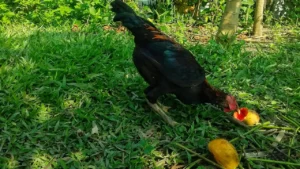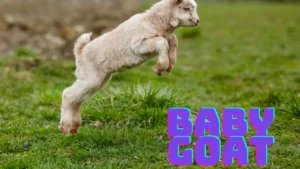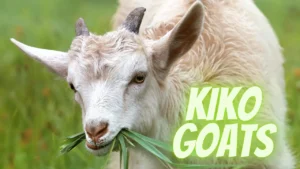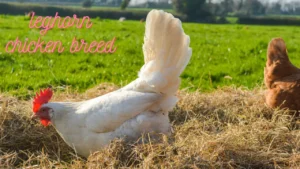Raising a baby goat during kidding season is both an exciting and sometimes stressful journey especially for those new to keeping goats. The birthing process comes with uncertainty, as you wait for the newborn goats to arrive and being prepared is key. From the first moments after delivery you need to assist the doe and provide proper care to ensure the little one grows into a healthy happy animal. Understanding the basics of goat rearing makes the experience truly rewarding and a good guide helps you learn how to feed, wean and raise them properly on the farm. This article will walk you through everything required to make the process smooth and enjoyable.
Essential Care Tips for Newborn Goats
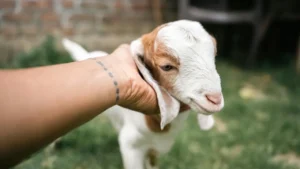
Here’s how to properly care for newborn goats after birth.
Clip the Umbilical Cord
After birth, gently trim the umbilical cord of the baby goat using a pair of disinfected scissors. To prevent infection dip the cord in iodine, using a small, plastic disposable shot glass for easy application. This simple step helps keep the newborn healthy.
Ensure the Newborn Goat Begins Nursing
A newborn goat must instinctively try to stand and nurse the doe to get colostrum which is important for a strong and healthy start. If the baby struggles gently help it to ensure proper feeding.
Weigh the Newborn Goat
It’s important to weigh the newborn goat and record its weight right after birth. Monitoring weight helps track growth, detect health issues early and ensure the baby is developing properly.
Tag the Baby Goat for Identification
Attach an ear tag or a temporary paper ID band to the baby goat for easy tracking. Be sure to write the dam’s number, date of birth and gender on the tag to keep proper records.
Keep Track of Essential Information
Keeping a record of each goat is essential for tracking health and growth. Use a notebook or a record-keeping app to log details such as gender, weight, ear tag, birth and any notable observations. Some prefer writing on a note pad before transferring data online into a system for better organization. If the internet connection in the barn is unreliable, a phone can still help store updates until you can move the records later.
Transfer the Doe and Kids to a Kidding Pen
After birth, move the doe and her newborn goats to a smaller kidding pen, also called a jug, for 24 to 48 hours. This helps with bonding and provides aid if needed. If there are more than two baby goats or the mom and kids need extra time, they should stay together in this space for another day to ensure a smooth transition.
Post-Kidding Care for Goats
Once the baby goat is dry, clean and has eaten it’s important to check on the doe to ensure she is doing well. Proper care after kidding includes:
- Providing freshwater with electrolytes to keep the doe hydrated.
- Offering a slice of high-quality alfalfa hay for proper nutrition.
- Monitoring her condition and ensuring she is comfortable.
- If assistance was needed during birth or if the baby had to be repositioned it’s necessary to give the doe antibiotics to prevent infection and aid recovery.
This care routine ensures both the doe and her baby goat remain healthy and strong after birth.
Essential Supplies for Goat Birthing
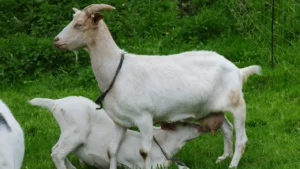
Preparing a birthing kit is crucial for the care of a baby goat when it arrives. Keep essential supplies ready, such as stainless steel scissors for cutting the umbilical cords, iodine for dipping and cleaning as a disinfectant, and small plastic shot glasses for a quick dip. A hanging digital scale with a sling helps to weigh newborn kids and track their weight. To keep the babies warm a hairdryer dedicated for kidding season is useful especially in cold weather.
Other necessary items include towels for wiping and drying the kids, a bucket for convenience, and a thermometer for checking temp if a kid seems inactive. Use paper bands to write important information like the mom’s name, gender, weight and date of birth. A stash of old bar mop towels can also be handy for extra cleaning. You can find all these supplies at Walmart or similar farm supply stores.
Essential Supplies for Goat Kidding
During kidding season, every farmer needs to be prepared for the exciting yet sometimes stressful moments when newborn goats finally arrive. The birthing process comes with uncertainty, as it’s hard to predict when the doe will need assistance.
Having the right supplies makes the delivery smoother and ensures proper care for both the mother and baby. A well-stocked shopping list should include a pair of disinfected scissors to trim the umbilical cord along with iodine to dip the cord and prevent infection. Using a small plastic disposable shot glass for the iodine makes the process quick and easy.
Once the kid is cleaned, it’s crucial to make sure it starts to nurse, as colostrum is essential for a strong, healthy start. Sometimes, the newborn goats may struggle to stand instinctively, so a little help may be needed. Keeping a video guide handy can be beneficial for those new to the process. It’s also important to weigh the baby and record its details.
Using a temporary paper ID band or an ID tag will help keep track of birth details such as weight, date, and gender. Farmers who want to promote their experience can share their journey through a blog post or affiliate links to recommend useful products. Having these steps in place ensures a smoother kidding experience and a better start for the little ones.
How much time is needed to wean a baby goat?
Feeding Milk to Baby Goats
Feeding a baby goat requires careful planning and the right equipment to ensure healthy growth. If the mother is unavailable or unable to nurse, a specialist bottle with a nipple designed for lambs or kids is essential. A proper milk replacement formula is needed for the infant goat, which should be fed four times a day for the first month and then reduced to three feedings daily. To make the baby goat comfortable with human contact regular handling is important and honestly who wouldn’t enjoy cuddling these little animals?
At one week old the goat can start to eat a small amount of grain along with drinking milk. By the end of the first month gradual addition of pasture time helps develop a more varied and nutritious diet. As the baby goat grows, its milk intake should slowly decrease to allow a smooth transition to an adult diet which consists of about 80 percent hay. Proper feeding ensures the young goat thrives and adapts well to its new dietary routine.
Pros and Cons of Baby Goats
Pros |
Cons |
| Friendly and playful making them great farm companions. | Require frequent feeding especially as newborns. |
| Help control weeds by grazing on unwanted plants. | Need a secure shelter to protect them from predators. |
| Can be raised for milk production or as pets. | Can be noisy especially when hungry or seeking attention. |
| Social animals that bond well with humans and other goats. | Prone to illnesses if not given proper care and nutrition. |
| Low maintenance compared to larger livestock. | Can be mischievous and may try to escape fences. |
FAQs About Baby Goats
When do baby goats start eating solid food?
Baby goats can start nibbling on hay and grain at one week old but they still need milk until they are fully weaned.
How often should I feed a baby goat?
Newborn goats need milk four times a day for the first month then three times a day as they grow.
Can baby goats drink cow’s milk?
It’s best to use a milk replacement formula made for goats as cow’s milk may cause digestive issues.
When should a baby goat be weaned?
Baby goats usually start weaning at four weeks and fully transition to solid food by 12 weeks.
How can I keep a baby goat healthy?
Provide a nutritious diet, regular human contact and ensure a comfortable and clean living space.
Conclusion
Raising a baby goat can be a rewarding experience, whether for farming, milk production, or as a pet. These playful and social animals bring energy to any farm and help with weed control. However, proper care, feeding, and shelter are essential for their growth and health. From providing the right milk replacement formula to ensuring a nutritious diet with hay and grain, every step plays a role in their development. Creating a safe and comfortable environment helps them grow into strong and healthy adult goats.
If you’re planning to raise a baby goat, understanding their feeding schedule, health needs, and social behavior is key. Regular handling and interaction make them more comfortable around humans, while proper fencing keeps them safe from predators. Whether you’re a beginner or an experienced farmer, having the right knowledge ensures your goats thrive. With the right care, your baby goat will grow into a valuable and lovable member of your farm or home.

